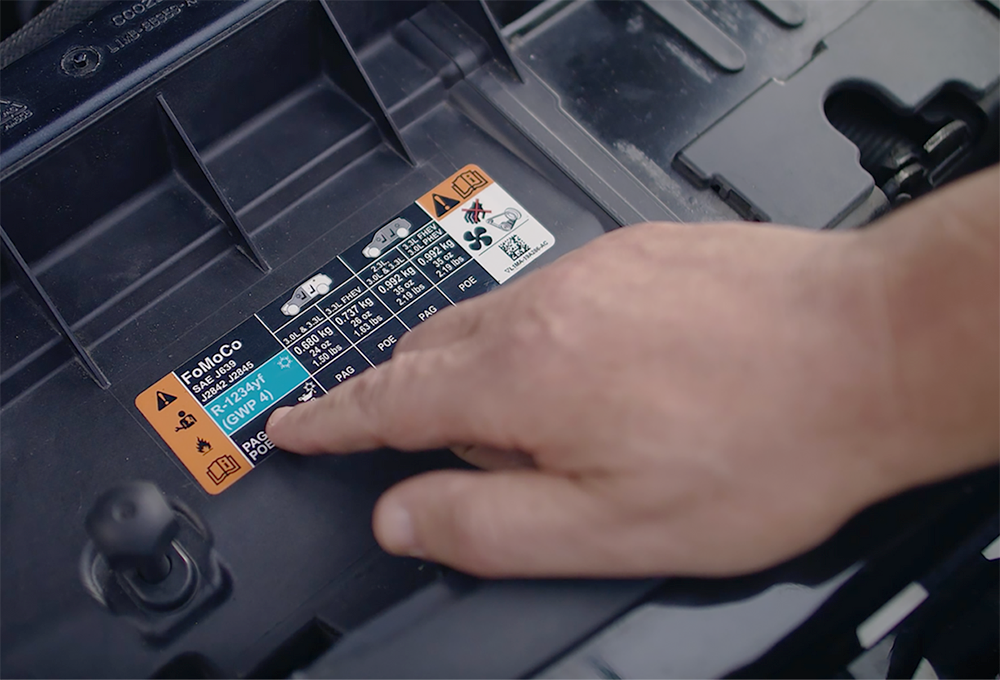 维修工人手持监测工具检查并修理汽车空调系统。(Shutterstock)
维修工人手持监测工具检查并修理汽车空调系统。(Shutterstock) 目前,美国销售的95%的新车都使用R-1234yf制冷剂。(Chemours)
目前,美国销售的95%的新车都使用R-1234yf制冷剂。(Chemours) 密歇根州的研究人员对雨水进行了测试,以找出TFA在当地环境中的聚集位置和方式。(The Ecology Center)
密歇根州的研究人员对雨水进行了测试,以找出TFA在当地环境中的聚集位置和方式。(The Ecology Center) 最近,一个环保组织联盟对密歇根州雨水中被广泛使用的PFAS进行了调查,并于 2024 年 8 月报告说,三个取样点中的两个TFA占比最大,第三个取样点中占比靠前。(The Ecology Center)
最近,一个环保组织联盟对密歇根州雨水中被广泛使用的PFAS进行了调查,并于 2024 年 8 月报告说,三个取样点中的两个TFA占比最大,第三个取样点中占比靠前。(The Ecology Center) 大众ID.4可配备使用R-744制冷剂(也称为二氧化碳)的热泵。(大众)
大众ID.4可配备使用R-744制冷剂(也称为二氧化碳)的热泵。(大众)
几乎所有在美国市场上出售的汽车均使用了四氟丙烯(R-1234yf)制冷剂,但欧盟目前正在酝酿关于该制冷剂的禁令,同时行业也在研究诸如二氧化碳和丙烷等替代制冷剂。
据R-1234yf的制造商科慕公司(Chemours)称,自R-1234yf取代已被广泛使用的四氟乙烷(R-134a)以来,其使用量大幅增长,且目前已用于美国市场95%的新车中。据估计,全球道路上约2.2亿辆汽车正在使用R-1234yf。被淘汰的R-134a自上世纪90年代开始广泛应用于汽车和卡车中,但美国环境保护署(EPA)的数据显示,这种气体冷却剂存在一个问题,即“其全球增温潜势(GWP)高达二氧化碳的1430倍。”
EPA研究了二氧化碳作为制冷剂替代方案的可行性,并得到了积极的结论。该环保机构表示其仍在“继续评估适用于机动车空调领域中的新型制冷剂替代方案。”
环保组织并未因此消除对三氟乙酸累积的担忧。密歇根州安娜堡生态中心的研究总监Jeff Gearhart在接受SAE采访时质疑道:“既然汽车制造商有能力识别出引发公众担忧的新兴化学物质,那么他们当初为何还要使用R-1234yf呢?汽车制造商的选择导致我们在还未识别出其潜在风险时,就使三氟乙酸成为了全球性污染物。”
旨在推动制冷行业清洁化的全球性组织ATMOsphere的资深编辑Michael Garry表示:“二氧化碳被视为[R-1234yf](尤其在电动车热泵领域)最具替代潜力的天然制冷剂。丙烷也被视为一种天然制冷剂替代方案,但在该领域中的关注度较低。”
欧洲汽车制造商协会(The European Automobile Manufacturers’ Association)在2023年发布的一份报告中指出,将R-1234yf系统替换为(使用二氧化碳的)R-744系统会导致每台汽车的空调成本上涨300欧元(334.73美元)。该报告称:“更换制冷剂意味着欧盟汽车制造商每年的制造成本将增加17亿欧元(18.9亿美元),从而导致其在全球市场上失去竞争力。”报告还预测,更换制冷剂将引发零部件短缺的问题。
According to its manufacturer, Chemours, use of R-1234yf has grown so much since the refrigerant replaced the long-established R-134a that it’s now used in 95% of new cars sold in the U.S. An estimated 220 million cars on global roads are also using it. The problem with R-134a, which came in cars and trucks in the 1990s, is that it’s a gas with “a global warming potential (GWP) that is 1,430 times that of CO2,” according to the EPA.
Since 2017, EU legislation has banned the use of any refrigerant in new vehicles with a GWP higher than 150. That rule doomed R-134a but opened the door for R-1234yf, which has a GWP of only four. The EU is currently revisiting R-1234yf emissions rules and may ban the substance in a few years. In the U.S., the EPA stands by its use.
Fighting over refrigerants is nothing new. In 2015, the European Commission took Germany to the Court of Justice because it was allowing automakers to use banned refrigerants. At the time, Daimler argued that R-1234yf could cause fires in front-end collisions, but the EU said, “these concerns were not shared by any other car manufacturer.” Chemours describes R-1234yf as “a thoroughly tested, mildly flammable refrigerant” and referenced an approval the European Commission gave in 2014 after a scientific review. Mercedes-Benz is now in favor of the newer refrigerant and said it has“ implemented a comprehensive safety concept to mitigate the potential risk of fire” on cars fitted with R-1234yf, spokesperson Pascal Becker told SAE Media.
But does R-1234yf also pose serious health problems when it degrades into the environment? Chemours defended its product vigorously to SAE Media, claiming that it “delivers a 99% reduction in global warming potential versus the incumbent refrigerant [R-134a], advancing global climate targets without compromising performance.” But concerns remain.
A 2021 study from the University of Bristol found that both R-134a and R-1234yf result in emissions of organic trifluoroacetic acid (TFA), but the latter is much worse in that regard. The study found that changing from one chemical to the other caused a “33-fold increase of the global burden of TFA, from an annual value of 65 tons formed from the 2015 emissions of 134a to a value of 2,200 tons formed from an equivalent emission of 1234yf.”
Chemours said that TFA is “more than 95% naturally occurring” and comes from“ a variety of manmade sources, including agriculture and pharmaceutical.” The company also said, “numerous independent studies conducted over the past two decades have concluded that TFA from manmade sources does not pose a risk to the environment or human health.” Chemours can point to a 2022 UN Environmental Programme report that found that produced TFA is distributed globally and evenly distributed. “This is unlikely to present a risk to humans or the environment in these locations, but changes in concentration in surface water (or soil) would respond rapidly to releases. Monitoring of the environment for residues of TFA would provide an early warning if trends in concentration indicate rapid increases,” the organization wrote.
The UN report confirmed that TFA has a very long life but did not sound a warning. “Because of its lack of reactivity, TFA salts are persistent in the environment, and estimates of half-life are uncertain but could be in the range of centuries or millennia,” the report said. “This persistence is not a major concern because it does not react with biomolecules. TFA and its salts are easily excreted by animals and do not bioaccumulate in food chains. Salts of TFA have low toxicity to animals and plants.”
Where the EPA stands
The EPA has taken a similar position, telling SAE Media that TFA “does not interact with biological molecules and, due to its high solubility in water, it does not bioaccumulate. It is unlikely to cause adverse effects in terrestrial and aquatic organisms.” The agency says that the TFA concentrations “that would be formed, even under high assumptions of use, would still be far below the threshold for causing adverse effects.”
As an alternative, the EPA has studied CO2 as a refrigerant and found it “acceptable.” EPA is also “continuing to evaluate new alternatives for [the] motor vehicle air-conditioning sector,” the environmental agency said.
Environmental groups are not convinced they should stop worrying about accumulating TFA. “The question is why the auto companies, with all of their ability to identify emerging chemicals of concern, were using R-1234yf in the first place?” Jeff Gearhart, research director at the Ecology Center in Ann Arbor, Michigan, told SAE Media. “This is yet another missed opportunity to identify a hazard before it becomes a global pollutant.”
The New Jersey Department of Health and Senior Services describes TFA as a “corrosive chemical,” exposure to which “can severely irritate and burn the skin and eyes with possible eye damage,” and cause “coughing, wheezing and/or shortness of breath.” And the German consulting and engineering firm Refolution Industriekälte GmbH said in 2021 that “TFA in drinking water can potentially damage the liver and have other impacts, for example, on the hormone system.”
The EPA declared R-134a “unacceptable” for new vehicles as of model year 2021 but has not taken any action against R-1234yf and does not classify it as an environmentally persistent per- and polyfluorinated substance (PFAS) chemical. A study from consulting firm Ducker Carlisle, however, said that “many OEMs and thermal-management suppliers anticipate that the EU will implement a regulation banning R-1234yf by 2030.” A proposal that would include it on a list of banned chemicals is under review at the European Chemical Agency, the report said.
The EPA did not respond to SAE Media inquiries on this subject. A 2023 petition to the European Parliament proposed banning R-1234yf and replacing it with carbon dioxide (CO2). The agency said this year that it was considering restricting the use of R-1234yf.
The auto industry is already investigating alternatives to R-1234yf. Dana Nicgorski, director of engineering at Bosch with responsibility for thermal management, told SAE Media that “the definition of what constitutes a PFAS is not standard in the world, and the European definition covers a whole lot more chemicals. Absent an EPA ban, some companies might adopt natural alternatives voluntarily.”
Bosch is studying CO2 and propane as future refrigerants. “Air conditioning and heat pumps are moving toward propane, and we think automotive will move next,” Nicgorski said. He added that propane is “thermodynamically superior” and systems using it will likely “cost a bit less than a system using 1234yf, with fewer components.” That latter point might blunt auto industry concerns, but the switchover is likely to be costly. Propane is a climate issue when burned but does not have a high GWP when released as a gas. Leaks might still be an issue, but Nicgorski said today’s hermetically sealed air conditioning units are not emitters like belt-driven systems.
At the ATMOsphere conference on refrigerant alternatives in Berlin in September 2024, Stefan Elbel, the head of TU Berlin’s department of heat transfer and heat conversion, said, “Time will tell which one is the better option, propane or CO2. From an environmental standpoint, though, you could say it doesn’t matter as both are great options.”
The EPA doesn’t necessarily agree, writing, “Hydrocarbon refrigerants, such as propane, are highly flammable and are not acceptable alternatives for motor vehicle air conditioners under the Clean Air Act and the EPA’s Significant New Alternatives Policy (SNAP) Program. The use of these refrigerants…can result in fire or explosion, possibly causing injury and property damage. It may also void your car’s warranty.”
Alternatives already available
Volkswagen Group started offering CO2-based, PFAS-free heat pumps in the ID.3 and ID.4 in 2020, as well as on the Audi Q4 etron. Ford’s electric Explorer, built on VW’s MEB platform, also has an optional CO2 heat pump. Ford has said that it sees propane, code name R290, as the best refrigerant for next-generation thermal architectures.
Michael Garry, editor at large for ATMOsphere, a global market accelerator with a mission to clean up cooling, said, “The natural refrigerant that is most slated to replace [R-1234yf] (particularly in electric vehicle heat pumps) is CO2. Propane is also discussed as a natural option but has gotten less traction in the field so far.”
The Alliance for Automotive Innovation, which represents over 20 automakers, declined to comment on a potential European ban on R-1234yf. Instead, it referred us to a letter it sent to Minnesota’s Pollution Control Agency in 2023 when the state was considering PFAS legislation. “Banning use of the refrigerant now currently used in our vehicles, as the Minnesota PFAS law might do, would…result in OEMs having to significantly redesign and re-engineer our recently revamped mobile air-conditioning systems and vehicles, possibly even with the need to retrofit older vehicles,” the Alliance said. “The definition of PFAS needs to be revised to exempt these substances.”
If TFA is officially labeled PFAS, it would run afoul of states that have enacted PFAS bans. California has one of the country’s strictest bans, but it was Maine that became the first U.S. state to ban the sale of products containing intentionally added PFAS and is scheduled to start addressing refrigerants in 2040.
Heidi Pickard, a postdoctoral fellow in the School of Engineering and Applied Sciences at Harvard who has studied TFAs, said, “Many of the [refrigerants] that are currently used…can degrade into short-chain PFAS like TFA, which is accumulating in the environment. Europe is pushing for the ban of PFAS as a class, but it’s unclear if this will include TFA.”
The European Automobile Manufacturers’ Association said in a 2023 report that switching from R-1234yf to an R-744 system (which uses CO2) would add 300 euros ($334.73) to the cost of making each car with air-conditioning. “This would mean a 1.7-billion-euro [$1.89 billion] increase per year for the vehicle manufacturers in the EU and loss of competitiveness on [the] worldwide market,” the report said. It also predicted parts shortages as a result of the change.
等级
打分
- 2分
- 4分
- 6分
- 8分
- 10分
平均分
